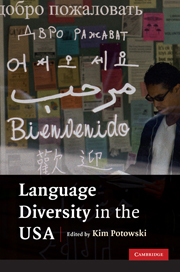Book contents
- Frontmatter
- Contents
- List of figures
- List of contributors
- Preface
- Acknowledgements
- 1 Language diversity in the USA
- 2 Language contact in the USA
- 3 Native American languages in the USA
- 4 Spanish in the USA
- 5 Chinese in the USA
- 6 Tagalog in the USA
- 7 French in the USA
- 8 Vietnamese in the USA
- 9 German in the USA
- 10 Korean in the USA
- 11 Russian in the USA
- 12 Italian in the USA
- 13 Arabic in the USA
- 14 Portuguese in the USA
- 15 Polish in the USA
- 16 Language policy in the USA
- Notes
- Media resources related to the top twelve non-English languages in the USA
- References
- Index
2 - Language contact in the USA
Published online by Cambridge University Press: 05 June 2012
- Frontmatter
- Contents
- List of figures
- List of contributors
- Preface
- Acknowledgements
- 1 Language diversity in the USA
- 2 Language contact in the USA
- 3 Native American languages in the USA
- 4 Spanish in the USA
- 5 Chinese in the USA
- 6 Tagalog in the USA
- 7 French in the USA
- 8 Vietnamese in the USA
- 9 German in the USA
- 10 Korean in the USA
- 11 Russian in the USA
- 12 Italian in the USA
- 13 Arabic in the USA
- 14 Portuguese in the USA
- 15 Polish in the USA
- 16 Language policy in the USA
- Notes
- Media resources related to the top twelve non-English languages in the USA
- References
- Index
Summary
Introduction
The USA presents rich terrain for studying processes and outcomes of language contact. Home to approximately 311 languages, it is not only the fifth most linguistically diverse country in the world (Gordon 2005), but also currently the fifth largest Spanish-speaking nation (CIA 2008). This multilingual reality is often overshadowed by the predominance of English, spoken by just over 80 percent of the largely monolingual population (US Census Bureau 2000a). Multilingual since time immemorial, the territory currently occupied by the USA has hosted a full gamut of contact phenomena, from instances where only a few words are borrowed from one language into another, to others in which new languages of various kinds are created. Long before Europeans arrived, many Native American groups solved the problem of communication across tribal boundaries through lingua francas (i.e. common languages) such as Mobilian Jargon (a pidginized form of Choctaw-Chickasaw in widespread use across the Mississippian complex), and Chinook Jargon (an interethnic pidgin spoken along the Pacific northwest coast from Oregon to the Alaska panhandle and inland along major rivers).
Three great waves of European colonization introduced English along with at least seven major languages (Danish, Dutch, French, German, Russian, Spanish, and Swedish), three of which (Spanish, French, and German) became prominent languages of immigration. Each of these provided sources for common American words (e.g. Swedish smorgasbord, Dutch scout, French prairie, German kindergarten, Spanish ranch).
- Type
- Chapter
- Information
- Language Diversity in the USA , pp. 25 - 46Publisher: Cambridge University PressPrint publication year: 2010
- 6
- Cited by



